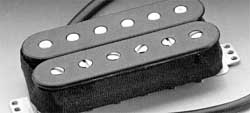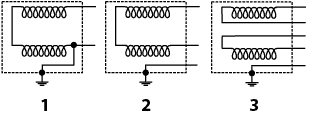

:: two single coils
:: windings connected out-of-phase: ends of windings connected,
beginnings of windings become leads
:: magnets in the two coils oppositely polarized
The humbucker - because of the way it is built - is unaffected by interference. It has two identical coils wired out-of-phase in a series connection, each with a different pole of the magnet facing the strings. Any interfering hum passed on via the air is now picked up by both coils, with the result of one coil cancelling the hum of the other. In order to prevent the same mutual cancellation of the current magnetically induced by the vibrating strings, the magnets in the two coils are placed in opposite directions, so that the top end of one coil is magnetically south and the top end of the other coil magnetically north. This has the additional advantage of the two currents adding up instead of cancelling each other out and the pickup producing a signal twice as strong as that of a single-coil pickup. A humbucker sounds "darker", bassier, more "middly" than a single-coil pickup because due to the distance between the magnetic poles of the two coils the strings induce two differing signals, leading to the cancellation of certain higher frequencies.

A humbucker consists of two identical coils that are normally connected in series, with the ends of the windings connected and the beginnings of the windings coming out from the coil as separate leads (or vice versa). One of these leads is often connected with a metal grounding plate (1), thus providing a shield for the pickup. In this case it is essential that this lead is also connected to ground. Although normally two leads are sufficient, you can get more tone options when the shield wire is turned into a third lead and is made accessible from outside (2). The maximum amount of wiring freedom on humbuckers is obtained with five leads (3) (the four coil wires (two beginnings, two ends) plus the ground wire).